ASSESSMENT OF PREVALENCE OF POST-VACCINE COVID-19 INFECTION AMONG DENTAL PROFESSIONALS AND STUDENTS OF DENTAL COLLEGES IN ERNAKULAM DISTRICT: A CROSS SECTIONAL STUDY.
Aneta K Abraham, Paul Jose, D’ Lima Johnson Prakash, Parackal Senny Thomas, Nair Sruthi K, Reshma TS
Department of Periodontics, Annoor Dental College & Hospital, Muvattupuzha
Received: 18 – 04 – 2022
Revised: 27 – 04 – 2022
Accepted: 10 – 05 -2022
Address for correspondence: Dr Aneta K Abraham, Postgraduate student, Department of Periodontics, Annoor Dental College & Hospital, Muvattupuzha, Email ID: anetaabraham94@gmail.com
This is an open access journal, and articles are distributed under the terms of the Creative Commons Attribution-Noncommercial ShareAlike 4.0 license, which allows others to remix, tweak, and build upon the work non-commercially, as long as appropriate credit is given and the new creations are licensed under the identical terms
How to cite this article: Abraham K A, Paul J, D’lima J P, Parackal S T, Nair S K, Reshma T S. Assessment Of Prevalence Of Post-Vaccine Covid-19 Infection Among Dental Professionals And Students Of Dental Colleges In Ernakulam District: A Cross Sectional Study. J Oral Biomed Sci 2022; 1: 62-71
Abstract
Aim: The aim of this study was to assess the prevalence of Covid-19 infection among all the immunized dental professionals and students in Ernakulam district of Kerala. Materials and Methods: A structured and validated questionnaire comprising of twelve questions was distributed to the students of five dental colleges in the Ernakulam district of Kerala. The questionnaire evaluated the vaccination status, dose and brand of vaccine received, duration of clinical practice, COVID -19 infection after vaccination, associated symptoms if any , among them. Results: The dental students included 307 females and 105 males , majority of them had contracted the disease even after immunization. 43 % of them had mild symptoms .The differences observed were significant (p < 0.05). Conclusion: Among the immunized dental professionals and students ,our study found a lower frequency of Covid -19 infection with a considerable decline in Covid symptoms.
Keywords: COVID -19, Immunization, Covishield , Dental professionals.
Introduction
Corona viruses (CoVs) belong to the subfamily Orthocoronavirinae in the family Coronaviridae, Order Nidovirales 1. Genome sequencing has shown that the 2019 new coronavirus (COVID-19), also known as the severe acute respiratory syndrome coronavirus 2 (SARS-CoV-2), is the culprit behind the coronavirus disease (2019-nCoV). 2,3 The symptoms include fever, dry cough, fatigue, shortness of breath, chills, muscle pain, headache, gastric disturbances and weight loss.4 Some patients may have lymphopenia and bilateral ground-glass opacity changes in the chest CT scans. However, a large population of the infected patients have no or mild symptoms and remain asymptomatic.5 Structurally coronaviruses are pleomorphic, enveloped viruses with a characteristic fringe of projections composed of S protein on their surface.6
Immunotherapy is considered as an effective method for the prophylaxis and treatment of various infectious diseases.7 Many efforts have been directed towards the development of the vaccines against COVID-19, among which, the most commonly administered were Covishield and Covaxin. Both Covihield and Covaxin are an intramuscular vaccine that follows a two dose regimen and is administered in the deltoid region of the individual by well-trained nurses.
Covishield has been developed by the Oxford-AstraZeneca and is being manufactured by the Serum Institute of India (SII). This vaccine has been prepared using the viral vector platform. A chimpanzee adenovirus – ChAdOx1 – has been modified to enable it to carry the COVID-19 spike protein into the cells of humans. Well, this cold virus is basically incapable of infecting the receiver but can very well teach the immune system to prepare a mechanism against such viruses. Here, the second dose is scheduled 84 days or 12-16 weeks after the first dose.
Current scientific evidence indicates that SARS-CoV-2 could be transmitted through various routes. Frontline healthcare personnel, especially the dental population who manage COVID-19 infected individuals and their family members are also at a high risk of contracting the disease as they often come in close contact with body fluids such as saliva and blood during dental procedures. Moreover, according to the available data, fully immunized individuals have also been observed to contract the infection.8 This necessitates further research to elucidate if Covishield has a true beneficial role in preventing COVID-19 infection in this population and if so, to assess the extent of protection it provides against the disease. So this current study aims to assess the prevalence of Covid-19 infection among all the immunized dental professionals in Ernakulam district of Kerala.
Materials and methods
The study was carried out among 412 dental professionals and students studying in the following dental colleges in Ernakulam district of Kerala:
- Annoor Dental College and Hospital, Muvattupuzha
- Amrita School of Dentistry (AIMS), Kochi
- Mar Baselios Dental College, Kothamangalam
- St. Gregorios Dental College, Chelad
- Indira Gandhi Institute of Dental Sciences, Nellikuzhi.
This is a cross sectional study where a convenient sampling method was used. A structured and validated questionnaire containing 12 questions in English were filled by the dental students individually through an online application called Google forms. Male and female dental students who were willing to participate, were enrolled in the study and, upon agreement, asked to give their E-consent for the same. Ethical approval for the study protocol was obtained from the Institutional Review Board (Annoor Dental College and Hospital, Muvattupuzha) and prior permission from heads of the respective institutions participating in the study were also obtained. The questionnaire comprised of twelve questions [Figure 1] which evaluated the vaccination status, dose and brand of vaccine received , duration of clinical practice, COVID -19 infection after vaccination, associated symptoms if any , among them. The gender and age of the participants were also documented. All the questions were explained to the participants and any doubt regarding them were clarified immediately by the principal investigator. The questionnaire was furnished in English language after ensuring that all of the participants could comprehend it.This study was conducted for a duration of 6 months.
All the data obtained were enrolled into Microsoft Excel and statistical package for social sciences (SPSS) version 24 was utilized for statistical analysis. Pearson Chi‑square test was used to evaluate the differences between the different variables, and the level of statistical significance was set at (p < 0.05).
Results
The study population comprised of 412 participants in the age group of 18 to 52 years. All the questions provided to them were answered and thus, included for statistical analysis. Among the 412 dental professionals and students who participated in the study, 105 (25.5%) were males and 307 (74.5%) were females [ Figure 2]. Majority of the population were vaccinated against COVID -19 (98%), among which 94.4% of them received Covishield and the rest were immunized with Covaxin [ Figure 3]. Most of the participants were engaged in clinical practice for about more than 50% of the duration in the post lockdown period, wherein 73.5% of them used all the preventive measures to protect themselves during the COVID -19 pandemic [ Figure 4 ]. Out of the 18 individuals who received Covaxin 10 were infected with Covid 19, whereas 176 among the 388 immunized with Covishield and 2 among the 5 immunized with Sputnik were infected [Figure 5] and most of them had contracted the disease after the second dose (127) . 43 % of them had mild symptoms [Figure 6].The differences observed were significant (p < 0.05).
Discussion
The year 2020 has seen 58 vaccines against SARS-CoV-2 being developed with some vaccines reportedly having more than 90% efficacy against COVID-19 in clinical trials. The vaccines under study now are based upon inactivated or live attenuated viruses, protein sub-unit, virus-like particles (VLP), viral vector (replicating and non- replicating), DNA, RNA, nanoparticles, etc. with each exhibiting unique advantages and hindrances.8 The investigators of four randomized, controlled trials conducted in the UK, South Africa, and Brazil report pooled results of an interim analysis of safety and efficacy against COVID-19 of the Oxford–AstraZeneca chimpanzee adenovirus vectored vaccine ChAdOx1 nCoV-19 (AZD1222) in adults aged 18 years and older.9 This is the first report of efficacy against COVID-19 for a non-profit vaccine aiming for global supply, equity, and commitment to low-income and middle-income countries (LMICs) . After phase 1 results supported a two-dose regimen, originally scheduled to receive a single dose to receive a booster more than 28 days after their first dose. The effectiveness of the Covishield vaccine is nearly 90% as per the global reports.
Among 627 persons with SARS-CoV-2 infection across 75 skilled nursing facilities (SNFs) since vaccination clinics began, SARS-CoV-2 infections were identified among 12 residents and 10 staff members across 15 facilities ≥14 days after receiving their second vaccine dose (i.e., breakthrough infections in fully vaccinated persons).10 Among 4,081 vaccinated healthcare workers in Israel, 22 (0.54%) developed COVID-19 from 1-10 days (median 3.5 days) after immunization.11
Frontline healthcare personnel, especially the dental population who manage COVID-19 infected individuals and their family members are also at a high risk of contracting the disease as they often come in close contact with body fluids such as saliva and blood during procedures. The world health organization (WHO) has recommended personal protective equipment (PPE) to doctors and health professionals attending COVID-19 patients. The PPE generally includes masks, goggles, gloves, and face shields.12 Moreover, according to the available data, fully immunized individuals have also been observed to contract the infection.
Benjamin Salmon et al. in a study among 4172 dentists and 1868 dental assistants of French oral health-care workers observed the prevalence of laboratory-confirmed COVID-19 was 1.9% for dentists and 0.8% for dental assistants. Higher prevalence was found for COVID-19-related clinical phenotypes both in dentists (15.0%) and dental assistants (11.8%).13
The result of our study revealed 50% of population being infected with covid 19 , in spite of immunization ,although with mild symptoms even with the use of personal protection barriers. Meanwhile another study among the US dentist in 2020 , revealed a low rates of cumulative prevalence (2.6%) and monthly incidence ranging from 0.2% through 1.1% reflect the high level of self-care among dentists.14
A major limitation of our study was the lack of participation from clinical practitioners. As the majority of the participants were students, this study was limited to younger age group. In addition, the clinical signs and symptoms of COVID -19 infection were not taken into account here.
Conclusion
Among the immunized dental professionals and students ,our study found a lower frequency of Covid -19 infection with a considerable decline in Covid symptoms. By means of providing the disease surveillance data, the results of our study may help decision makers adapt and optimize clinical guidelines for infection prevention and control during this pandemic and potentially future waves.
Conflict of interest: None
Financial support and sponsorship: Nil
REFERENCES
- Banerjee A, Kulcsar K, Misra V, Frieman M, Mossman K. Bats and coronaviruses. Viruses. 2019 Jan;11(1):41.
- Xu X, Chen P, Wang J, Feng J, Zhou H, Li X, Zhong W, Hao P. Evolution of the novel coronavirus from the ongoing Wuhan outbreak and modeling of its spike protein for risk of human Science China Life Sciences. 2020 Mar;63(3):457-60.
- Wong JE, Leo YS, Tan CC. COVID-19 in Singapore—current experience: critical global issues that require attention and action. Jama. 2020 Apr 7;323(13):1243-4.
- Centers for Disease Control and Coronavirus Disease 2019: COVID-19.
- Shang W, Yang Y, Rao Y, Rao X. The outbreak of SARS-CoV-2 pneumonia calls for viral npj Vaccines. 2020 Mar 6;5(1):1-3.
- Kaur SP, Gupta V. COVID-19 Vaccine: A comprehensive status report. Virus research. 2020 Aug 13:198114.
- Masihi Fighting infection using immunomodulatory agents. Expert opinion on biological therapy. 2001 Jul 1;1(4):641-53.
- Gagneux-Brunon A, Detoc M, Bruel S, Tardy B, Rozaire O, Frappe P, Botelho-Nevers E. Intention to get vaccinations against COVID-19 in French healthcare workers during the first pandemic wave: a cross-sectional survey. Journal of Hospital Infection. 2021 Feb 1;108:168-73.
- Wang N, Shang J, Jiang S, Du L. Subunit vaccines against emerging pathogenic human Frontiers in microbiology. 2020 Feb 28;11:298.
- Voysey M, Clemens SA, Madhi SA, Weckx LY, Folegatti PM, Aley PK, Angus B, Baillie VL, Barnabas SL, Bhorat QE, Bibi S. Safety and efficacy of the ChAdOx1 nCoV-19 vaccine (AZD1222) against SARS-CoV-2: an interim analysis of four randomised controlled trials in Brazil, South Africa, and the The Lancet. 2021 Jan 9;397(10269):99-111.
- Teran RA, Walblay KA, Shane EL, Xydis S, Gretsch S, Gagner A, Samala U, Choi H, Zelinski C, Black Postvaccination SARS‐CoV‐2 infections among skilled nursing facility residents and staff members—Chicago, Illinois, December 2020–March 2021. American Journal of Transplantation. 2021 Jun;21(6):2290-7.
- Amit S, Beni SA, Biber A, Grinberg A, Leshem E, Regev-Yochay Postvaccination COVID- 19 among healthcare workers, Israel. Emerging Infectious Diseases. 2021 Apr;27(4):1220.
- Covid C, Team R. CDC COVID-19 Response Team. Severe outcomes among patients with Coronavirus disease 2019 (COVID-19)—United States, February 12–March 16, 2020. MMWR Morb Mortal Wkly Rep 2020; 69 (012) 343-346
- Jungo S, Moreau N, Mazevet ME, Ejeil AL, Biosse Duplan M, Salmon B, Smail-Faugeron V. Prevalence and risk indicators of first-wave COVID-19 among oral health-care workers: A French epidemiological survey. PloS one. 2021 Feb 11;16(2):e0246586.
- Araujo MW, Estrich CG, Mikkelsen M, Morrissey R, Harrison B, Geisinger ML, Ioannidou E, Vujicic M. COVID-19 among dentists in the United States: A 6-month longitudinal report of accumulative prevalence and incidence. The Journal of the American Dental Association. 2021 Jun 1;152(6):425-33.
QUESTIONNAIRE FOR ASSESMENT OF THE PREVALENCE OF COVID-19 INFECTION AMONG IMMUNIZED DENTAL PROFESSIONALS AND STUDENTS IN KERALA.
- Age ______________
- Gender ____________
- College ______________
- Designation
- UG student
- PG student
- Teaching staff
- Have you been vaccinated against COVID 19?
- Yes
- No
- Which brand of vaccine did you receive?
- Covishield
- Any other :_____________
- How many doses of vaccine have you received?
- One dose
- Two doses
- Not applicable
- For what duration of the post lockdown period have you been engaged in clinical practice?
- Less than 25%
- 25%
- 50%
- More than 50%
- What are the preventive measures you have taken to protect yourself during the COVID19 pandemic?
- PPE
- N95 mask
- Face shield
- Double masking
- Double gloving
- All of the above
- Have you ever been infected with COVID 19?
- Yes
- No
- If so, when did you contract the disease?
- Before the vaccination
- After the first dose
- After the second dose
- Not applicable
- How many days after the vaccination did you contract the disease?
- Days ______________
- Not applicable
Figure 1. Questionnaire
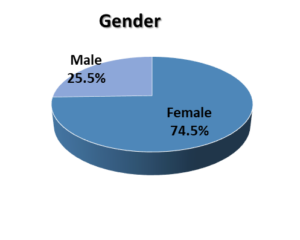
Figure. 2 Study population.
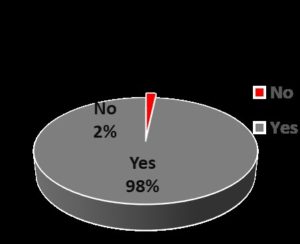
Figure.3 Vaccination Status
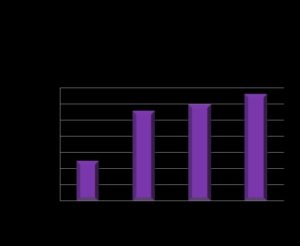
Figure.4 Duration of clinical practice in post lockdown period
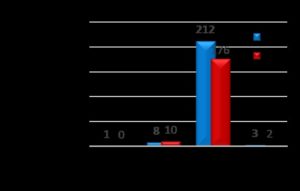
Figure.5 Covid 19 infection among the vaccinated dental professionals
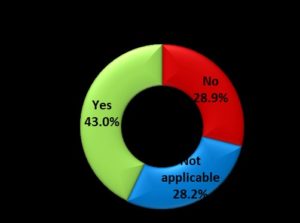
Figure.6 Covid symptoms



